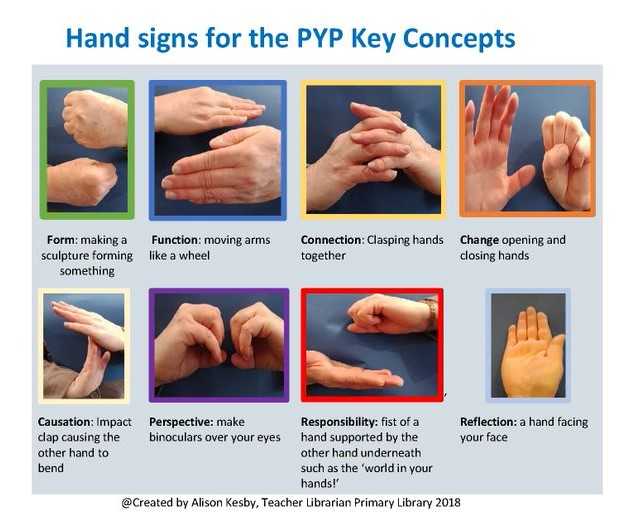The IB Primary Years Program (PYP) has seven key concepts that are crucial tools. Each key concept has an associated key question that helps a learning community to inquire. Which are:
Form – What is it like?
Function – How does it work?
Causation– Why is it as it is?
Change– How is it transforming?
Connection – How is it linked to other things?
Perspective– What are the points of view?
Responsibility – What are our obligations?
An effective strategy to emphasise concepts, is to tap into the physical dimension, the kinaesthetic aspect and use hand signs.

The idea of developing hand signs grew from singing action songs, use of non-verbal cues in teaching, and the link to the educational pedagogy of multimodal learning; the Visual, Auditory, and Kinaesthetic (VAK). Combining actions and singing assists with memory and communication. The pedagogical influence of multimodal thinking combining the visual, auditory, and kinesthetics also enhances memory. Thus, a natural transition was to create a distinctive hand sign for each of the key concepts.
In the early years hand signs have been introduced separately within each unit of inquiry. Making a hand sign has been used as a tool to prompt a specific question matching a central idea or line of inquiry. Hand signs have also been used more generally when students are making connections, taking responsibility, or considering a point of view. In Upper Primary, students have been using the hand signs as a prompt to unpack an inquiry and as a reflection tool. The hand signs were displayed to communicate the students’ chosen concepts for a Year 6 Exhibition.
I have also created a ‘Key Concept Rap’ in which each key concept is repeated three times, followed by the matching key question while doing the hand sign. For example, “Perspective, Perspective, Perspective, What’s your point of view?” In addition to the hand signs being used by students from Kindergarten to Year 6 to think conceptually, the rap makes an excellent lesson break.
Additional hand signs have now been created including reflection that is a hand facing your face like a mirror. I was excited when a student invented a hand sign for peer reflection – two hands facing each other with a little wave. I also introduced the action of drawing an arc in the air, like the top of an umbrella to represent transdisciplinary themes, and a sign to prompt students to share the central idea under that.
Within a PYP inquiry, hand signs can quickly assist students and teachers in remembering the PYP terminology, unpack an inquiry, emphasize a conceptual lens, prompt a question, form a rap, and be a reflection tool.
I look forward to students and teachers trialling the use of the hand signs and providing feedback on their impact.

Alison Kesby has more than 30 years of experience in primary school education as a classroom teacher and teacher librarian, including many years as a Primary Teacher Librarian at Canberra Grammar School. She has a strong interest in developing conceptual understanding, research and thinking skills with students and staff from Pre-Kindergarten to Year 6.

Using the seven Key concepts, we are able to find the essential information for the learning Lesson to study.
As stated in the paragraph, the associated key questions play an important role in order to create an effective strategy.
In the course, I was able to learn about the transdisciplinary learning needed in PYP, in addition, we were able to practice some activities in which we were able to use transdisciplinary themes and approaches to learning.
The PYP concepts can be applied by using hand signs, additionally, the usage of the hand signs covers the PYP terminology because by using the hand signs you are able to clearly determine the key concepts and transdisciplinary themes.
The course was full of activities and exercises that helped us reflect on what PYP really is and how to apply it in our classrooms.
Full of useful content that created a fundamental and practical learning experience to take to the classroom.
Has anyone developed hand signs for the Learner Profile attributes?
This sounds really interesting can not wait to take it into my classroom. thank you!